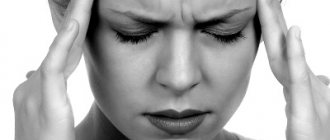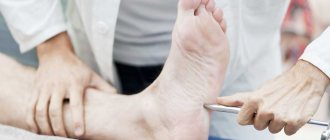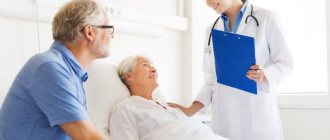1.What is neuropathic pain?
Neuropathic pain, or neuropathic pain as it is also called, is complex chronic pain that is usually accompanied by tissue damage.
With neuropathic pain, the nerve fibers themselves can be damaged. Because of this, injured nerve fibers send incorrect signals to pain centers. In addition, due to injury, nerve function can be disrupted both in the area of injury and in surrounding areas.
One example of neuropathic pain is phantom syndrome, or phantom syndrome.
. This rare condition occurs when an arm or leg is amputated due to disease or injury, but the brain still receives signals of pain in the amputated part of the body and senses the limb and its apparent movement.
A must read! Help with treatment and hospitalization!
(End of the material. Read the beginning here).
Sergei Gapanovich, head of the pain treatment room, anesthesiologist-resuscitator of the department of anesthesiology and resuscitation of Mogilev Hospital No. 1, chairman of the Belarusian Society for the Study of Pain. Treatment
Principles of Pharmacotherapy for NB
1. Formation of adequate patient expectations from treatment.
2. Initiation of systemic therapy with lower doses with gradual titration to medium and maximum, taking into account tolerability.
3. Prediction and monitoring of side effects.
4. Sufficient duration of therapy.
5. Continuity and complexity of treatment.
Emphasis must be placed on multidisciplinary interaction. Non-pharmacological, non-invasive techniques should be used as early as possible. These are physical therapy, gymnastics, massage, sleep hygiene, rehabilitation, cognitive-behavioral, mirror therapy, repetitive transcranial magnetic stimulation, transcranial direct electric current stimulation.
In 2021, an international group of specialists dealing with the problem of NB proposed an algorithm (published in the journal Pain Medicine), which covers all aspects of both non-drug and drug therapy, minimally invasive (interventional) treatment, as well as surgical methods (neurostimulation, installation of intrathecal pumps) . To achieve results, it is important to pay attention to the sequence in performing all stages.
Pharmacotherapy Reasons for the ineffectiveness of pharmacotherapy for NB in real practice:
- inadequate titration regime,
- insufficient dose of the drug,
- intolerable side effects,
- low compliance with therapy,
- lack of consideration of comorbid pain disorders and somatic disorders that limit the prescription of drugs.
To overcome the problem of NB resistance:
- stepwise titration of the dose of anticonvulsants and antidepressants to an effective dose (300 mg of pregabalin, 1800 mg of gabapentin, 60 and 120 mg of duloxetine),
- starting therapy with an evening dose,
- minimum dose titration period 3–7 days,
- lower doses in the elderly and frail, in patients with impaired renal function (for example, 25 mg pregabalin),
- warning about possible side effects.
Minimally invasive (interventional) methods of treating NB include:
- therapeutic and diagnostic blockades of nerves and plexuses,
- epidural administration of steroids (intralaminar, transforaminal, caudal),
- pulsed radiofrequency ablation,
- adhesiolysis (administration of hyaluronidase, iso- or hypertonic sodium chloride solution, steroids through a catheter),
- sympathetic blockades (complex regional pain syndrome),
- radiofrequency and cryodenervation.
Key points of surgical neuromodulation:
- confirmed diagnosis of NB,
- should precede the prescription of strong opioids,
- pain intensity more than 50/100 points on the VAS scale,
- duration of pain more than 6 months,
- previous adequate pharmacotherapy,
- effectiveness of test stimulation (>50% pain reduction) as part of complex multimodal therapy.
In light of the problem of resistant NB (up to 5%), surgical methods become especially relevant.
When installing intrathecal drug pumps in countries with effective pain services, narcotic analgesics are most often used - morphine as a single drug or in combination with bupivacaine, as well as clonidine, baclofen, ziconotide. Patients requiring prescription of >50 morphine-equivalent opioid units (required >90) are included. The technique is used when the effect of the current treatment regimens for NB (resistant NB) is insufficient, and side effects are intolerable. An important condition is the absence of mental illness that could affect the result.
Clinical case: conclusion
Let's return to the patient's problem described at the beginning of the article. The case has typical presentations of postherpetic neuralgia, including a clear history of herpes zoster, dermatomal continuous and paroxysmal pain, and allodynia.
After assessing pain (using the DN4 questionnaire), we would begin treatment with topical formulations such as 5% lidocaine patches (based on some clinical evidence of effectiveness and very low risk of side effects) or 8% capsaicin patch.
If adequate benefit is not achieved, pregabalin or gabapentin should be added: they have efficacy similar to that of tricyclic antidepressants, with a lower risk of serious side effects (taking into account the patient's age and comorbidity).
Such patients should return to normal physical and social activities as soon as possible. If movement is difficult due to pain, physical therapy and early mobilization are indicated.
Patients should be informed of both the benefits and potential side effects of therapy. They must understand that improvement will not be immediate and that changes in treatment strategy will likely be required.
Regular follow-up is necessary to assess the effectiveness of pain relief, side effects, satisfaction with treatment, and daily functioning. If pain relief is not enough, the dosage of drugs is increased. If the patient has an inadequate response to therapy or bothersome side effects, switching to a tricyclic antidepressant may be considered, and referral to a pain management specialist may be considered to discuss interventional treatment options.
!Unfortunately, the patient did not receive vaccination against herpes zoster, which significantly reduces the risk of developing postherpetic neuralgia.
conclusions
What is important in the treatment of NB:
- confirmation of diagnosis and etiology,
- etiological therapy,
- management of associated factors (diabetes mellitus, depression, obesity),
- patient education,
- titration of all systemic drugs,
- pharmacotherapy for at least 6 months in an individually selected dose.
Many drugs commonly used in the treatment of pain are potentially ineffective (NSAIDs, paracetamol, benzodiazepines, antipsychotics, antiepileptics that affect sodium channels (oxcarbazepine, lamotrigine), serotonin reuptake inhibitors, etc.).
Today, local forms of lidocaine 5%, capsaicin 8% in the form of transdermal therapeutic substances are not available on the Belarusian drug market; injections of botulinum toxin type A are not used in the treatment of NB.
It is worth thinking about vaccination against herpes zoster (especially at-risk groups - older people), which will avoid serious consequences in the form of difficult-to-treat NB.
In cases of refractory symptoms, doctors supervising patients with NB should promptly include interventional and surgical methods in the treatment regimen.
It is necessary to develop a national pain service that can increase the availability of modern therapies.
2. Causes of pain
There often seems to be no obvious cause for a patient's neuropathic pain. But doctors identify several types of common causes of such pain:
- Alcoholism;
- Amputation;
- Problems with the back, legs and hip area;
- Chemotherapy;
- Diabetes;
- Facial nerve problems;
- HIV infection or AIDS;
- Multiple sclerosis;
- Shingles;
- Spinal surgery.
Visit our Neurology page
Exercise and inflammation
Chronic pain is always accompanied by inflammation. Damaged tissues release biologically active molecules, inflammatory cytokines (tumor necrosis factor TNF-α, interleukin1-beta IL1-β and others), which affect the nervous system, causing pain. During neuropathic pain, many proinflammatory cytokines, especially TNF-α, are actively synthesized in the spinal cord. But the same tissues also synthesize anti-inflammatory cytokines (IL-10, IL-6), some protein mediators and opioid peptides, which suppress pain caused by inflammatory factors. The overall effect depends on which factors predominate. Physical activity often promotes a powerful release of anti-inflammatory cytokines, weakening the inflammatory response and pain.
It is true that people react differently to physical activity, and some experience increased inflammatory reactions, but in general, exercise can provide relief to patients with chronic pain. Both strength and endurance exercises are beneficial. Both reduce levels of inflammatory cytokines and increase levels of anti-inflammatory molecules, the high levels of which remain long after the end of the workout. Researchers observe this effect in both young and old people.
Experiments have shown that training that reduces inflammatory factors reduces cold and mechanical allodynia and increased sensitivity to pain. The interaction between inflammation, pain and exercise is presented in more detail in Figure 2.
Effect of exercise on neuropathic pain
Knowledge of the molecular basis of the analgesic effect of exercise is still incomplete, research in this area continues, but known facts allow the use of physical activity as an analgesic. Testing of any new drug begins in the laboratory, testing it primarily on mice and rats. Training was no exception. Researchers paid special attention to pain associated with diabetes. In one experiment, treadmill running reduced many forms of allodynia in sick rats, including mechanical, cold, and heat. However, overuse can cause damage and the pain returns. Researchers cannot yet determine the load at which training no longer has a therapeutic effect.
Neuropathic pain is often caused by the cytostatic drug paclitaxel, which also leads to the loss of sensory receptors on the skin. Treadmill exercise alleviates these symptoms.
For pain caused by spinal cord injury, treadmill exercise reduces pain and improves nerve function up to five weeks after the injury.
As a rule, both aerobic training and endurance exercise are effective. Only static loads for pain are harmful; they only increase pain sensitivity. The intensity and duration of training is of great importance. For example, running on a treadmill stimulates nerve growth at low intensity but not at high intensity. Intense short-term training significantly reduces mechanical allodynia due to chronic tissue compression. But these are all preliminary remarks, and further research is needed for detailed instructions.
Swimming received particular praise. It helps with nerve damage by reducing both mechanical allodynia and heat sensitivity; reduces hypersensitivity to pain caused by nerve damage, cold, and high temperature. Swimming suppresses the synthesis of some inflammatory factors and stimulates the synthesis of adenosine, the interaction of which with adenosine receptors reduces mechanical allodynia. Swimming may be an optimal option for patients with neuropathies, as it can reduce the stress on sore limbs. It also avoids problems with coordination of movements that occur in many patients, especially the elderly. But before swimming can be used in the clinic, more research is needed.
Another question to be answered is how soon after injury can you start training. There are many studies reporting positive results from exercise started in the first week after injury. Treadmill exercise started three days after a sciatic nerve injury has immediate and long-term benefits, regardless of the duration of the workout. Exercise started after five days prevents the development of neuropathic pain. A week after the injury, it was possible to reduce temperature and tactile hypersensitivity. These studies show that there is no need to wait. However, different disorders affect movement control differently, so the training program must be selected individually.
3. Symptoms and diagnosis
Symptoms of neuropathic pain
Signs of neuropathic pain usually include shooting sensations, burning pain, as well as tingling and numbness in the affected parts of the body.
Diagnosis of neuropathic pain
A physical examination is required to diagnose neuropathic pain.
.
During it, the doctor will ask you how you can describe your pain, when it occurs, and whether the pain is associated with any specific causes and factors. The doctor may also ask you for blood tests and nervous system test results.
About our clinic Chistye Prudy metro station Medintercom page!
Effects of exercise on sensory pathways
The painful nerve impulse travels along the sensory afferent nerve, through the spinal cord and thalamus and ends in the corresponding zone of the cortex. Exercise also activates the sensory nerves coming from the muscles, causing changes along the entire nerve pathway. Everything that is currently known about these changes, scientists have found out in experiments on mice and rats. So, training allows you to normalize the number of epidermal receptors that perceive pain. In the sensory neurons of the spinal ganglia, they activate the synthesis of various nerve growth factors and neurotrophic factors. Exercise stimulates the division of Schwann cells, which support axons and nourish neurons. Thus, training stimulates the regeneration of peripheral nerves, which is important for neuropathies.
Neuropathic pain often occurs in diabetes. This disease and its consequences are being studied in rodents fed fatty foods. But the mice that ran in the wheel did not develop insulin resistance and did not get sick.
Physical activity has a beneficial effect not only on the peripheral nervous system, but also on the central one. There is little research on this topic. For example, exercise is known to reduce phosphorylation of the NR1 subunit of the NMDA receptor in the brainstem, thereby reducing pain perception.
Aerobic or endurance exercise increases nitrate levels in the blood plasma and cerebrospinal fluid. When the scientists performed these experiments on rats that were unable to synthesize nitric oxide, the exercises lost their pain-relieving properties, so the researchers believe that nitric oxide may act as an analgesic.
Physical activity stimulates the synthesis of endogenous opioid peptides in the brain stem. They have analgesic properties, however, according to some experts, the cannabinoid system, which is also activated during training, may also play a significant role in pain relief.
Apparently, the analgesic effect of exercise consists of several factors and is successfully combined with medication. For example, risedronate, a drug prescribed for osteoporosis, was more effective at increasing bone mineralization when rats given it were forced to exercise on a treadmill.
More detailed information about the effect of physical activity on the nervous system is given in Figure 1.








